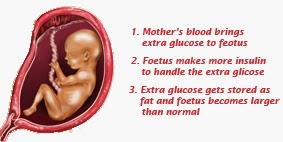tipstipskehamilan. What causes gestational diabetes ? Gestational diabetes generally occurs in women who do not have diabetes, but during their pregnancy, they have high blood sugar. This kind of diabetes is different from that of a pregnant woman who was previously diabetic before getting pregnant. Gestational diabetes is one of the most common health problems of pregnancy and approximately 10% of pregnant women have gestational diabetes. Here some causes gestational diabetes.
 During pregnancy pregnant woman's body needs additional insulin that is secreted by the pancreas. When the pancreas fails to meet the increased demand, blood glucose levels rise too high, resulting in the onset of this disease.
During pregnancy pregnant woman's body needs additional insulin that is secreted by the pancreas. When the pancreas fails to meet the increased demand, blood glucose levels rise too high, resulting in the onset of this disease.Gestational diabetes usually develops during the last half of pregnancy or after the first trimester (three months) of pregnancy without knowing exactly symptoms suffering from gestational diabetes before they get tested. In diabetes during pregnancy the actual problem lies not with the pancreas but with the placenta.
After the first trimester (three months) of pregnancy the functions of the placenta is takes over the support and growth of the foetus (baby in the womb). The placenta produces hormones (that help in baby development) that impede with the body's natural response to insulin, which results in a condition referred to as "insulin resistance".
When pregnant woman's body is not able to make and use all the insulin it needs for pregnancy, glucose builds up in the blood to high levels that is called hyperglycemia. It is caused by glucose that can not leave the blood and be changed to energy because not enough insulin.
Immediate care must be taken to prevent gestational diabetes harmful to both the mother and the baby. Treatment always includes a specific diet plan, close blood sugar monitoring, and possibly even daily insulin injections.
If medication is not quite right or if the diet plan is not being followed correctly, there is a risk of hypoglycemia. The opposite of hyperglycemia, hypoglycemia occurs when there is not enough glucose in the blood.
Generally, gestational diabetes disappears post birth of a child. But once you have had it, you have a greater chance it will surface again in future pregnancies.